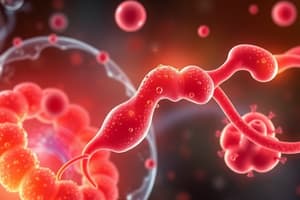Podcast
Questions and Answers
What happens when insulin levels are low in the body?
What happens when insulin levels are low in the body?
- Glycogen breakdown in the liver increases
- Blood sugar levels drop significantly
- Ketone bodies production decreases
- The body breaks down fats for energy (correct)
Which of the following is NOT a common complication of diabetes mentioned in the text?
Which of the following is NOT a common complication of diabetes mentioned in the text?
- Skin problems
- Vision loss
- Bone fractures (correct)
- Cardiovascular disease
What organ is primarily affected by neuropathy in diabetes?
What organ is primarily affected by neuropathy in diabetes?
- Kidneys
- Pancreas
- Liver
- Nerves (correct)
What is a serious consequence of untreated diabetic ketoacidosis?
What is a serious consequence of untreated diabetic ketoacidosis?
How does insulin resistance affect blood sugar levels in the body?
How does insulin resistance affect blood sugar levels in the body?
What is the primary cause of elevated blood sugar levels in individuals with insulin resistance?
What is the primary cause of elevated blood sugar levels in individuals with insulin resistance?
In type 1 diabetes, what is the underlying cause of the absolute deficiency in insulin production?
In type 1 diabetes, what is the underlying cause of the absolute deficiency in insulin production?
How does insulin help regulate blood sugar levels?
How does insulin help regulate blood sugar levels?
Which of the following is a potential complication of diabetes?
Which of the following is a potential complication of diabetes?
What is the primary metabolic disturbance that characterizes diabetic ketoacidosis?
What is the primary metabolic disturbance that characterizes diabetic ketoacidosis?
Flashcards are hidden until you start studying
Study Notes
Diabetes Mellitus: Insights into Insulin Resistance, Pancreatic Beta Cells, Blood Sugar Regulation, Complications, and Diabetic Ketoacidosis
Background
Diabetes mellitus, commonly referred to as diabetes, is a group of metabolic disorders characterized by chronic hyperglycemia due to defects in insulin production or function. Insulin resistance, pancreatic beta cells, blood sugar regulation, complications, and diabetic ketoacidosis are all integral parts of understanding the complexities of diabetes.
Insulin Resistance
Insulin resistance occurs when insulin's ability to regulate blood sugar is compromised, leading to elevated blood sugar levels. This can be caused by factors such as obesity, physical inactivity, certain medications, and genetic predisposition. As a result, the body's cells become less responsive to insulin, requiring higher amounts of insulin to maintain normal blood sugar levels.
Pancreatic Beta Cells
The pancreas contains specialized cells called beta cells, which produce insulin. In people with type 1 diabetes, the immune system mistakenly attacks and destroys these beta cells, leading to an absolute deficiency in insulin production. In contrast, individuals with type 2 diabetes initially have normal or even increased insulin secretion but develop resistance to insulin action over time.
Blood Sugar Regulation
Insulin plays a crucial role in regulating blood sugar levels by promoting glucose uptake in muscle, fat, and liver tissue. It also inhibits the breakdown of glycogen in the liver, thereby reducing glucose release into the bloodstream. In the absence of insulin or when insulin becomes less effective, blood sugar levels become elevated, leading to hyperglycemia.
Complications of Diabetes
Over time, high blood sugar levels can cause damage to various organs and systems throughout the body. Common complications include cardiovascular disease, nerve damage (neuropathy), kidney damage (nephropathy), vision loss, skin problems, and foot ulcers. The risk of developing these complications is influenced by factors such as duration of diabetes, age of diagnosis, poor control of blood sugar, and genetic predisposition.
Diabetic Ketoacidosis
Diabetic ketoacidosis is a serious complication that can occur in people with type 1 diabetes when their body produces high levels of ketone bodies. This can happen when insulin levels are low, causing the body to break down fats for energy, generating large amounts of acids called ketones. Left unchecked, diabetic ketoacidosis can lead to coma and death.
In summary, understanding the complex relationship between insulin resistance, pancreatic beta cells, blood sugar regulation, complications, and diabetic ketoacidosis is essential for managing diabetes effectively. Early detection and appropriate management strategies play a significant role in preventing or minimizing the impact of diabetes-related complications.
Studying That Suits You
Use AI to generate personalized quizzes and flashcards to suit your learning preferences.





